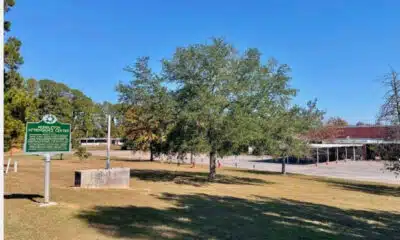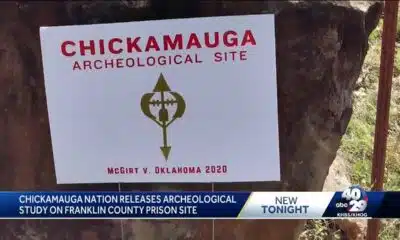News from the South - North Carolina News Feed
While the U.S. veered right, western NC moved left. Here’s what experts say causefd it • Asheville Watchdog
[Editor’s note: This article was originally published by NC Newsline. Asheville Watchdog is republishing it with its permission.]
Democrats looking for signs of growing support around the country found few reasons for optimism this November. Western North Carolina was the exception.
As a nationwide red wave crashed over the United States on election night, a scattering of counties in the region broke the other way. Henderson, Buncombe, and Transylvania counties each voted about 4 points more Democratic in 2024 than in 2020, and Haywood, Mitchell, Ashe, and Gaston counties also saw shifts to the left from 1 to 3 points.
Longtime political observers have differing explanations as to why this happened. Some pointed to the impact of Tropical Storm Helene and the politics of the recovery, while others saw evidence of the continuation of a longer trend toward Democrats in a region that has historically been a stronghold for Republicans.
The progress for Vice President Kamala Harris was not enough to offset substantial losses in the east, where the Democratic ticket failed to turn out traditional supporters of the party — a pattern echoed across the country, even in safe Democratic states like New York and New Jersey. But it kept the state among the closest in the country with just more than 3 percent of the vote separating Harris from President-elect Donald Trump, a tighter margin than all but six states.
The Helene factor
The story of western North Carolina in 2024 cannot be told without considering the devastation from Helene. But while observers anticipated significant impacts to the election from the storm, it’s not clear that this political trend is one of them.
About a fifth of registered voters in North Carolina live in counties that were part of the federal disaster declaration from Helene. The severe damage to infrastructure from the storm raised concerns that a large portion of those voters could be left unable to participate in the election. But exhaustive efforts by state and county election officials, along with rapidly enacted legislation expanding ballot access in those counties, helped assure that by the start of early voting, every affected county was able to accept in-person voters.
While some expected vote totals in the region to be depressed, western North Carolina actually saw near record turnout in 2024, above the statewide average. According to the North Carolina State Board of Elections dashboard, counties in western North Carolina saw an average turnout of about 76.7 percent of eligible voters, roughly 3 points higher than turnout statewide, which was just more than 73.7 percent.
On average, Harris improved on President Joe Biden’s margins in the disaster-affected counties and fell short of his performance outside of them. She grew her vote total by an average of 0.1 percent of the vote in the counties where a disaster was declared while losing 3.4 percent on average across the rest of the state. Her performance in western North Carolina was 6.2 percent better than her performance nationally — a stark contrast to a seismic shift toward Trump.
The counties in that disaster zone span the political spectrum, with some, like Wilkes County, giving almost 80 percent of their vote to Trump while others, like Buncombe County, gave more than 60 percent of the vote to Harris — her sixth-best tally in the state. But in all 25 of them, she outperformed the national change in margin, with Trump’s best result being a 2.9 percent gain in Wilkes and hers a 4.26 percent gain in Henderson.
Chris Cooper, a political science professor at Western Carolina University, said it was difficult to distinguish whether the shift toward Democrats could be attributed to the storm or longer-term regional shifts.
“I tend to think it is more likely to be the continuation of trends, because the rest of the ‘Helene 13’ didn’t have similar movement,” Cooper said, referencing the 13 counties most severely affected by the storm. “Another solution is that people made different voting decisions based on the storm, which I find harder to believe. The third possibility in my mind is that the storm might have had a differential impact on turnout.”
Of those 13 counties, just six saw a shift toward Harris greater than one percentage point: Haywood, Ashe, Mitchell, Transylvania, Buncombe, and Henderson. Polk, Avery, and Madison counties moved less than a point in her direction, while Trump’s margin increased from 2020 in Yancey, McDowell, Rutherford, and Watauga counties.
Cooper said it was “a real possibility” that the storm uniquely depressed turnout among Republicans despite the overall increase in turnout. He said anecdotally, the regions of those counties that were hardest hit by Helene appear to be more Republican-leaning than those that were spared.

One data point supporting a Helene effect, according to NC State political science professor Andrew Taylor, is a similar pattern in the heavily Republican region of northwest Georgia, which also faced severe impacts from Helene. Like western North Carolina, several counties in this region bucked national trends and moved toward Harris.
Taylor added that while heavily Republican areas might be more likely to see an improvement in Harris’s numbers by virtue of a “dead cat bounce,” this would not explain improvement in the Democratic stronghold of Buncombe County, which he said could be “suggestive of a positive hurricane effect for Democrats.” But he remained skeptical of a Helene effect overall, citing similar Harris overperformance in central North Carolina and the fact that Trump did just “marginally better” in the state as a whole than in 2020, in contrast to substantial improvement in non-swing states around the country.
Morgan Jackson, a longtime Democratic consultant, said he believes that separate from the storm itself, Republican disinformation around the recovery effort hurt the party among western North Carolina voters. He denounced the “rampant lies and conspiracy theories” about federal disaster relief spread by Trump and gubernatorial candidate Mark Robinson.
“There were so many North Carolinians who were struggling that were getting direct help from FEMA,” Jackson said. “I think ultimately, that soured a lot of voters on Republicans in the west and sent the signal down ballot and allowed Democrats to do better.”
An area of focus for Democrats
Long before Helene created a political firestorm in the region, North Carolina Democrats had their sights set on the region as an opportunity for growth.
“From the Stein [gubernatorial] campaign, and it’s true from other statewide campaigns, we paid particular interest out west as a place that we felt there was opportunity to grow,” Jackson said. “We believe that voters in the west, based on polling — even Republican voters — were less likely to support really extreme candidates.”

In Jackson’s telling, the falsehoods spread about the response to Helene — from claims that federal dollars for disaster relief had been siphoned off to fund aid for migrants, to wild conspiracies that the Biden administration had engineered the storm for political purposes — only further raised the salience of extremism in the 2024 campaign.
Some of that skepticism among western North Carolina voters comes from the differing demographics of the region, with some of the counties that showed the greatest increases for Harris home to more retirees and college-educated voters than other parts of the state — groups where Trump’s rhetoric has alienated many voters rather than drawing them in.
“They might be Republicans, but they’re college-educated Republicans who are retiring to the mountains of western North Carolina, who are are more resistant to the social media conspiracy theorism that you see sort of running rampant in Republican circles these days,” Jackson said.
He said those factors manifested not just at the top of the ticket, but down ballot as well, giving North Carolina Democrats one of their strongest performances in the mountains in years. The data bear this out — Governor-elect Josh Stein, who improved on Democrats’ 2020 gubernatorial margin in all but 13 counties, performed especially well in the counties in the west. His margin grew by 11 percent of the vote in the 25 counties impacted by Helene and by 6 percent in all other counties.
Notably, Stein won Transylvania and Henderson counties outright, the first Democrat to do so in the governor’s race since 2004 and 1980, respectively. Stein improved his margin by about 15 percent of the vote and 17 percent in those two counties, two of his largest improvements statewide alongside other western counties like Gaston, Lincoln, Haywood, and Buncombe counties, all of which saw more than 13 percent improvements by the incoming governor.

Democratic overperformance in the western part of the state may have been key to their expected disruption of the GOP supermajority in the General Assembly. Rep. Lindsey Prather (D-Buncombe) won her race by less than 3 percent of the vote in one of the state’s closest races — in a district that appeared to favor Republicans after redistricting, which Prather herself estimated leaned Republican by about a point. Were she to have lost that race, Republicans would have held onto their supermajority in the North Carolina House of Representatives, rendering Stein’s veto power useless.
“I was hyper-focused on my race in [House District] 115 and haven’t had time to dig into the data for the rest of WNC,” Prather wrote in an emailed statement. “I know these county parties have been working hard and intentionally for years to build a community but I’m sure that’s happening in other counties too. In my race, I worked hard to earn trust and show people the good that government can do when the right people are allowed to govern.”
Not to be discounted is a renewed focus on rural communities by the state Democratic Party under chair Anderson Clayton, who has undertaken an “every county” strategy in her first term as chair, with North Carolina Democrats contesting all but two of the state House seats up for election in 2024. Democrats in western North Carolina, largely mountainous and rural, may have benefited from increased attention this cycle.
“Our hope is to really help bridge the gap over the next coming years into making sure that we are talking to every community about Democratic policies, that this year does not just stop,” Clayton said in a Johnston County news conference leading up to the election. “Our work after this is to keep knocking doors and helping people know what Democrats are doing for them each and every day.”
A longer-term trend
To Thomas Mills, a longtime North Carolina Democratic consultant, the shift toward Democrats in western North Carolina appears to be more a product of physical movement than political movement.

“They’re more educated voters that are transplants,” Mills said of the changing makeup of the counties that moved toward Harris. “For years, I’ve had the belief that one of the greatest predictors of which way you’re going to vote is the length of time you’ve been in the state.”
He noted that counties like Clay County — which unlike some of the other counties in the mountains, shifted about half a point toward Trump in 2024 — have received considerably less migration than their neighbors. Without that influx of educated retirees, they tend to vote much the same as they have for years.
Mills said the trend will likely continue as the makeup of these counties shifts toward more highly educated, wealthier electorates — and it could spill over to exurban counties like Cabarrus and Madison as transplants to Charlotte and Asheville seek more economical alternatives to city living.
Cooper, the western North Carolina-based political scientist, observed that the trend is not a new one — and reflects a longer term drift of some counties in the west away from the Republican Party under Trump.
“Between 2016 and 2020, Henderson County and Buncombe County were also some of the biggest movers away from Trump,” Cooper said. “A little bit of it is perhaps a continuation of a previous trend.”
Like Harris, Biden overperformed in western North Carolina. He improved on Hillary Clinton’s margins in almost every county in the western part of the state, with particularly strong growth in Henderson, Buncombe, and Transylvania counties, all of which moved 6 to 9 points toward Democrats. That Harris continued to improve in these three counties even while falling short of Biden’s margin in the state suggests an enduring trend toward Democrats in this cluster of counties.
“Buncombe County has been moving to the Democrat column for years, so it just may have moved another step. Transylvania could be a similar explanation, you know, it’s sort of become a retiree place,” said Carter Wrenn, a North Carolina Republican strategist who ran Ronald Reagan’s 1976 primary operation in the state. “It just doesn’t strike me as any sort of a big move.”
A point in favor of the demographic story is that not all counties in the west mirrored the shifts seen in those three. Were rural organizing or Helene responsible for these changes, places like Rutherford, Jackson, and McDowell counties would also likely be moving toward Harris. But many of the counties that saw slight shifts toward Democrats in 2020, including those latter three, moved back toward Republicans in the 2024 cycle.
Still, the results in the west may provide some guidance for Democrats to learn from amid their upcoming four years of soul-searching. To understand what went wrong for the party in the rest of the country, it could be valuable to learn what went right in this region.
“Henderson County was red yesterday, is red today, and will be red tomorrow,” Cooper said. “But the margins for Republicans are getting smaller, so to me, it illustrates the power and the importance of looking under the hood a little bit beyond just who ‘won’ or ‘lost’ a county.
Asheville Watchdog is a nonprofit news team producing stories that matter to Asheville and Buncombe County. Brandon Kingdollar covers North Carolina government and state politics for NC Newsline. The Watchdog’s reporting is made possible by donations from the community. To show your support for this vital public service go to avlwatchdog.org/donate.
Related
The post While the U.S. veered right, western NC moved left. Here’s what experts say causefd it • Asheville Watchdog appeared first on avlwatchdog.org
News from the South - North Carolina News Feed
July 4 travel tips as people hit the road
SUMMARY: This 4th of July weekend, a record-breaking 72 million Americans are expected to travel, with over 61 million taking road trips, creating heavy traffic. To avoid delays, AAA advises leaving early, ideally before 11 a.m., but only after thorough vehicle checks like tire pressure, battery, and having an emergency kit with essentials and a charged phone. Meanwhile, air travel will see over 5.8 million passengers amid packed airports and fewer flight routes, leading to crowded planes. Travelers should allow extra time at airports to avoid rushed sprints. Preparation is key for smooth, safe holiday travel both on roads and in the skies.
We’re only a few days from Fourth of July celebrations.
More: https://abc11.com/
Download: https://abc11.com/apps/
Like us on Facebook: https://www.facebook.com/ABC11/
Instagram: https://www.instagram.com/abc11_wtvd/
Threads: https://www.threads.net/@abc11_wtvd
TIKTOK: https://www.tiktok.com/@abc11_eyewitnessnews
News from the South - North Carolina News Feed
Hundreds charged in health care fraud crackdown, including some in Triangle
SUMMARY: A nationwide healthcare fraud crackdown has led to charges against over 320 people, including some in North Carolina’s Triangle area. The fraud involves schemes like paying patients for treatments, receiving kickbacks from labs, and providing unnecessary medical equipment or therapy bills to Medicare and Medicaid. Acting U.S. Attorney Daniel Bubar highlighted cases such as a substance abuse clinic accumulating $25 million through kickbacks and equipment providers charging $39 million for unneeded items like knee braces. Immigrant communities were targeted for fraudulent services. Nationwide, defendants billed over $14.6 billion in false claims, prompting intensified enforcement in the Eastern District of North Carolina.
Some Triangle-area cases include issues of paying patients to receive treatment and getting kickbacks from a lab, sending medical equipment to people who didn’t need it and targeting immigrant communities to receive services that they didn’t need or never received.
News from the South - North Carolina News Feed
Frozen: How scientist are trying to prevent species from going extinct
SUMMARY: The San Diego Zoo’s Frozen Zoo, celebrating 50 years, preserves skin, egg, and sperm cells from over 1,300 species to prevent extinction. Founded by Dr. Kurt Benirschke before cloning technology existed, it stores cells frozen indefinitely without feeding. The Frozen Zoo has helped revive critically endangered animals like the California condor and black-footed ferret. Scientists emphasize the urgency as many species face rapid decline. Their current mission is to train global facilities to replicate this effort, preserving biodiversity and genetic diversity to support vulnerable populations worldwide and enhance conservation efforts.
“Jurassic Park” raises that sticky ethical question about whether scientists should essentially play God by reviving extinct species. But one team at the San Diego Zoo is doing what they can to prevent species from going extinct in the first place.
https://abc11.com/
Download: https://abc11.com/apps/
Like us on Facebook: https://www.facebook.com/ABC11/
Instagram: https://www.instagram.com/abc11_wtvd/
Threads: https://www.threads.net/@abc11_wtvd
TIKTOK: https://www.tiktok.com/@abc11_eyewitnessnews
-
Mississippi Today5 days ago
Defendant in auditor’s ‘second largest’ embezzlement case in history goes free
-
News from the South - Louisiana News Feed7 days ago
3 lawsuits filed against CVS, Louisiana AG announces
-
Our Mississippi Home6 days ago
From ‘I’m Bored’ to ‘Let’s Explore’: A Summer Scavenger Hunt Through Mississippi History
-
News from the South - Missouri News Feed7 days ago
Residents provide feedback in Kearney Street Corridor redevelopment meeting
-
News from the South - Louisiana News Feed7 days ago
Louisiana’s energy efficiency ‘slush fund’: $80 million, few rules
-
News from the South - Texas News Feed6 days ago
The Rio Grande Valley as Heart of LGBTQ+ Resistance and Joy
-
News from the South - Georgia News Feed4 days ago
Are you addicted to ‘fridge cigarettes’? Here’s what the Gen Z term means
-
News from the South - Arkansas News Feed7 days ago
Tribal organizations releases archaeological study over proposed Franklin County prison site












































